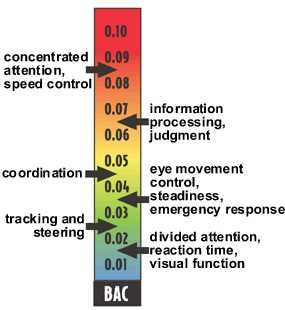
BLOOD ALCOHOL CONTENT (BAC)
BAC Over the Legal Limit?
Experienced Fort Lauderdale Criminal Defense Attorney Aggressively Defends DUI Charges for Clients Throughout Florida
A breath test, blood test, or urine test can be used to determine a person’s BAC (blood alcohol content) rating. Although a person’s BAC may be above the legal limit in some jurisdictions, it may be below the legal limit in others. According to law, this criminal offense does not actually require a person to be driving a vehicle; rather the person only has to be in physical control of the car.
| Blood Alcohol Concentration (BAC) |
Typical Effects | Predictable Effects on Driving |
| .02% |
|
|
| .05% |
|
|
| .08% |
|
|
| .10% |
|
|
| .15% |
|
|
| provided bynhtsa.gov | ||
Field sobriety tests may be used to determine whether a person is intoxicated to the extent that their normal faculties are impaired. Although field sobriety tests may be used, BAC is the strongest evidence that law enforcement can use to determine whether a person was driving under the influence. If a person submits to a breath test and his or her BAC was above the legal limit, or if a person refused to submit to a breath test, then he or she may face penalties such as having their license suspended.
Broward criminal lawyer, Kenneth Padowitz, has successfully challenged driver’s license suspensions at DMV hearings as well as criminal charges in courts throughout South Florida. He has been practicing Criminal Law for almost 30 years. Fort Lauderdale criminal defense attorney Kenneth Padowitz provides effective representation for clients facing DMV administrative hearings, federal and state criminal charges relating to DUI cases, and other serious offenses throughout Broward and all of South Florida, including: Fort Lauderdale, Miami, Palm Beach, Parkland, Weston, and Boca Raton. Contact our law office and ask for Kenneth Padowitz.


